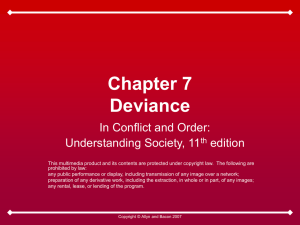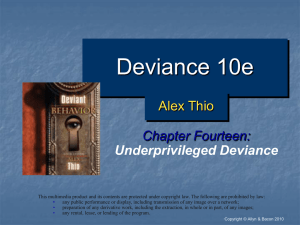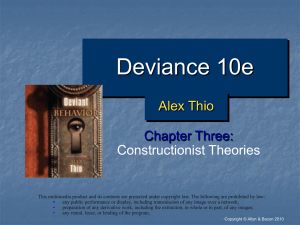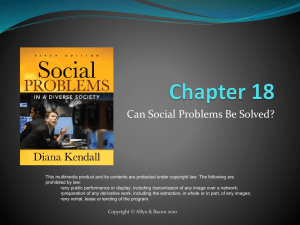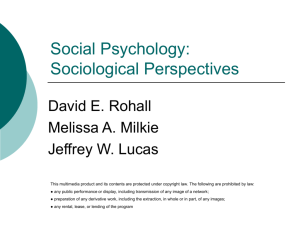Chapter 2
advertisement
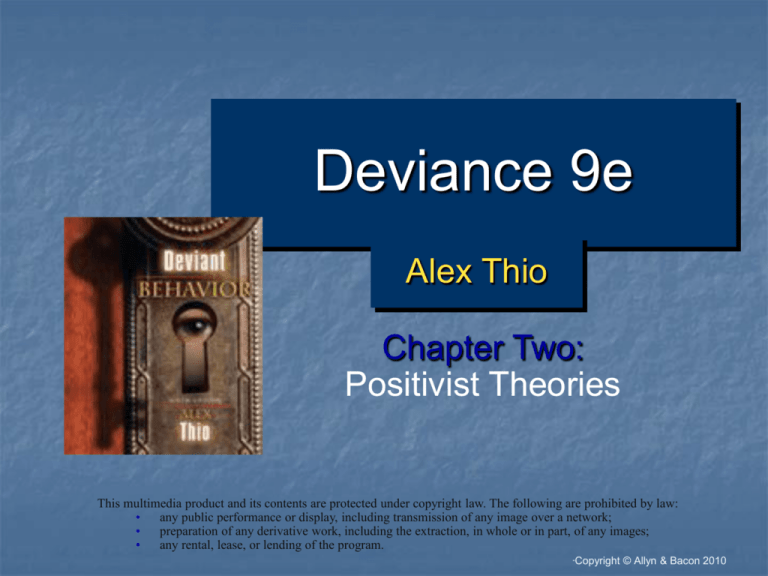
Deviance 9e Alex Thio Chapter Two: Positivist Theories This multimedia product and its contents are protected under copyright law. The following are prohibited by law: • any public performance or display, including transmission of any image over a network; • preparation of any derivative work, including the extraction, in whole or in part, of any images; • any rental, lease, or lending of the program. “ Copyright © Allyn & Bacon 2010 Introduction Positivists try to explain horrible deviant acts, such VA Tech shootings, through past social experiences (ex. Inadequate or flawed socialization and grievances against society) “ Copyright © Allyn & Bacon 2010 Anomie-Strain Theory Anomie: breakdown of social norms A-S theory examines how anomie causes deviance Merton focused on goals-means gap Ways in which society encourages deviant behavior (by setting unreasonable goals but not the tools needed to attain them) “ Copyright © Allyn & Bacon 2010 Anomie-Strain Theory – cont. Durkheim: anomie is absence of norms and this leads to deviance Merton: (Different view than Durkheim) deviance occurs when society encourages individuals to commit it by creating a type of pressure that promotes deviance “ Copyright © Allyn & Bacon 2010 Anomie-Strain Theory – cont. Merton: Legitimate means of success not freely available to all classes Lower classes are trapped into resorting to illegitimate means to achieve success (the level of success promoted by social institutions as normal, appropriate and attainable) By encouraging high aspirations and denying avenues of success, society inadvertently creates deviance Conformity: accepting both society-approved goals and means Innovation: use of illegitimate means to achieve socially accepted/promoted high success goals Ritualism: abandoning high success goals but pursuing legitimate work Retreatism: withdrawal from goals and means of society Rebellion: rejection of prevailing social expectations and support for overthrowing the system (ex. social institutions, bureaucracy, etc.) “ Copyright © Allyn & Bacon 2010 Albert Cohen: Status Frustration Cohen modified Merton’s strain theory by introducing the delinquent subculture driven by status frustration According to Cohen, lower-classed youths react (status frustration and reaction formation) to the unreasonable middleclass measuring rod (social expectations) by turning to deviance “ Copyright © Allyn & Bacon 2010 Anomie-Strain Theory – cont. Cloward & Ohlin: extended Merton’s theory by focusing on differential illegitimate opportunities 3 types of illegitimate opportunities/subcultures: 1. 2. 3. Criminal subculture; youth achieve goals by stealing, robbing and fencing (moving stolen goods) Conflict subculture; violent gangs give status to thugs Retreatist subculture; drug use “ Copyright © Allyn & Bacon 2010 Anomie-Strain Theory – cont. New direction in A-S theory: More emphasis on U.S. culture that values success by any means Pursuit of economic success leads to lack of concern for others and promotes self interest Exploring other areas of strain, e.g. death of loved one, serious illness and relationship problems Presence of negative stimuli, e.g. child abuse and neglect “ Copyright © Allyn & Bacon 2010 Social Learning Theory Deviant behavior is learned through one’s interaction with others like any other behavior Sutherland: deviance occurs in people who have more concentrated criminal than anti-criminal contacts (differential association) “ Copyright © Allyn & Bacon 2010 Social Learning Theory – cont. Glaser’s differential identification theory: individual must identify with criminals Burgess & Akers’ differential reinforcement or social learning: people will engage in criminal activity if rewarded “ Copyright © Allyn & Bacon 2010 Control Theory Explores why people conform, not deviate; accepts Freudian idea that deviance can occur naturally, without social control Hirshi: strong bonds to society ensure conformity while weak bonds lead to deviant acts Tittle: lack of control balance – too little or too much control over others -- can cause deviance Braithwaite: proposed shaming as form of social control Disintegrative shaming – Shunning, Stigmatization, banishment, etc. Reintegrative shaming – More positive in that the wrongdoer is shunned and banished, but then openly welcomed back into the community. “ Copyright © Allyn & Bacon 2010 Control Theory – cont. Deterrence doctrine: emphasizes role of formal social control in deterring deviance Assumes that humans are rational and will continue to commit crime unless the cost (punishment) is severe Severity, certainty and swiftness all can influence crime rate General deterrence: deter public from committing crime through punishment examples Specific deterrence: meant to deter criminals from committing more crime “ Copyright © Allyn & Bacon 2010


